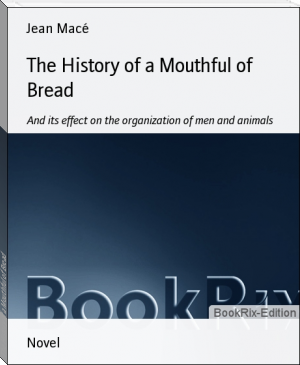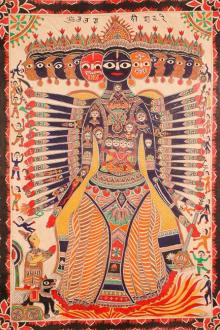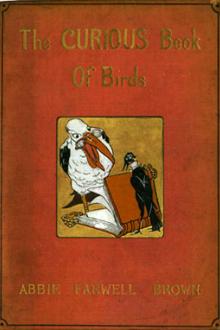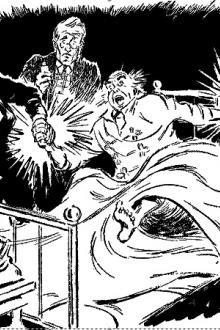The History of a Mouthful of Bread, Jean Macé [best autobiographies to read TXT] 📗

- Author: Jean Macé
Book online «The History of a Mouthful of Bread, Jean Macé [best autobiographies to read TXT] 📗». Author Jean Macé
real names of whatever has figured in our story.
The two great compartments are called ventricles, the two small pouches auricles, and they are also distinguished as being on the right or left side;- right ventricle, left ventricle, right auricle, left auricle.
The inner doors on which depends all the action of the machine, are called valvelets. By-and-bye, when the pump and the steam-engine are explained to you, you will meet again with these treacherous doors, which never allow what has once entered to go back again; but then we shall call them valves.
The air-reservoir, I need scarcely tell you, is the lung, to which the blood goes to put itself in contact with the air.
The subterranean watercourse, of which I hope we have talked long enough, is the small intestine, in which the chyle collects; and the tubes which run into it are, of course, the chyliferous vessels, the only channels by which anything reaches the heart which has not previously gone out from it.
The tubes of distribution, which run out from the machine in all directions, are called with us arteries ; the return tubes, which bring back the water to the machine, are called veins.
Finally, we have not exactly the filters employed to clear the water from the impurities contracted as it goes along, for no such thing exists in us. There are in our case the refuse-chambers of which I have already spoken, in connexion with the liver, where the blood disembarrasses itself of any useless materials, and from which it comes out with clean pockets, so to speak, reverting to the comparison of which we have already availed ourselves.
As you see, then, everything comes round again; and the bright idea which our professors hit upon in order to satisfy the caprice of the banker is exactly carried out in your own body, only a thousand times more perfectly than could have been done by them all, even with all their science added to all his money.
I mentioned that the shrewdest of the party boasted about making an artificial heart. But, let me tell you, there is one thing I would have defied him to imitate, by any expedient he could devise, and that is the inimitable construction of the arteries and veins, and the incomprehensible delicacy of their innumerable ramifications.
Let us talk a little about these marvellous tubes, and begin with the arteries, which have the most important part to play.
Did you ever see a doctor try the pulse of his patient? Take hold of your own wrist and search a little above the thumb. You will soon find the place and feel something beating against your finger. There is an artery which passes there, and the little beating you feel is the rebound of the pulsations, of your heart. Every time that the left
ventricle, by contracting itself, chases the blood into the arteries, these, of which the tissue is very elastic, become distended all at once, and then contract again, repeating the process whenever a fresh gush of blood arrives, so that their movement is exactly regulated by the movement of the heart. It is true the two movements are in a contrary direction; that is to say, the artery becomes distended, while the heart contracts, and contracts when the heart enlarges itself; but that makes no difference to the doctor. What he wants to know is, with what force and rapidity the heart of the patient beats, and I will explain why. It is an interesting point in the history of circulation.
When you were very little-very little indeed, my dear child-your heart beat from 130 to 140 times in a minute. Afterwards the beats sank to 100 per minute; then to fewer still. At present I cannot tell you the precise number: perhaps, about ninety. When you are a grown-up young lady, it will beat about eighty times in the minute; when you are a mother, about seventy-three times; when a grandmother (if such a blessing be granted you), only from fifty to sixty times, perhaps even fewer. People tell of an old man of eighty-four whose heart beat only twenty-nine times in the sixty seconds.
Observe that in all my calculations I have taken special care to prefix the word about to the numbers mentioned. And this because, in point of fact, the heart is a capricious creature, which has no exact rules to go by. It changes its pace on every occasion-fear, joy, every emotion which agitates the soul, quickens or retards its movements; and derangements of health may be detected by its pulsations, which are infinitely varied in character. In fever, for instance, which is nothing but a race of the blood at full speed, the hearts of grown-up people beat as quickly as those of little children; sometimes, indeed, more quickly still. In certain maladies it goes with great sudden leaps, like a galloping horse; in others it trots in little jerks; while in some cases it moves slowly and wearily, and its throbs are so weak that one can scarcely feel them.
These pulsations, then, afford important revelations to the doctor. The heart is for him a gossiping confidant, who lets out the secrets of illnesses, however closely they may fancy themselves hidden in the remote depths of the body. When the doctor lays his finger on the patient's pulse, it is precisely the same thing to him as if he had laid it on his heart, only with this difference, that the one is much less difficult to do, and much sooner done than the other.
The artery of the wrist is in fact a small heart, not only because it follows all the movements of the large one, but because it carries forward the work which the other begins, and assists also in propelling the blood to the furthest extremities of the limbs, driving it on in its turn at each of its own contractions. Imagine a fire-engine, whose pipes should take up and drive forwards along their whole length the water which is thrown upon the fire, and you will have some idea of the marvellous machine which is at work in our behalf within us. Nor are you to suppose that the wrist-artery is a specially privileged one, because it has been chosen to hold intercourse with physicians. All the others are equally serviceable; and if they cannot all be used for "feeling the pulse," it is because they are generally more deeply buried in the flesh, where it is not easy to reach them.
Observe your mother when she is packing a trunk, and you will see that whatever she is most afraid maybe spoiled, she is most careful to put in the middle, so that it may be least exposed to accidents. And this is what a kind Providence has done with the arteries, which have the utmost cause to dread accidents; whilst the veins, which are much better able to bear rough usage, are allowed to wander about freely just under the skin. But when the bones happen to take up a great deal of room, and come near the skin themselves, as is the case in the wrist, the artery is forced, whether he likes it or not, to venture to the surface, and then we are able to put our fingers upon him.
And there are others in the same sort of situation; the artery of the foot for instance. But only just think how far from agreeable it would be to have to take off your shoe and present your foot to the doctor!
The artery which passes to the temple, just by the ear, is another affair. That would answer the purpose very well in fact, and I even advise you to make use of it when you want to feel your own pulse. It is more easily found than the other even, and its pulsations are still more easily perceptible. Nevertheless, when all is said and done, it is better for the doctor to take his patient by the hand than by the head. Merely as a matter of good manners.
I will now make you acquainted with the principal arteries, and the manner in which they distribute the blood through the body.
The whole of the blood driven out by the left ventricle at each of its contractions, passes into one large canal called the aorta . The
aorta as it goes away at first ascends; then bends back in a curve; and from this curve, which is called the arch of the aorta (from its shape) diverge right and left, certain branch-pipes which carry the blood into the two arms and on each side of the head; and which are, in fact, the beginning, or upper end, of those whose pulsations we feel with our fingers in the two wrists and at the temples.
The supply to the upper part of the body being secured, the aorta begins to descend. But now imagine of what importance it must be, that this head-artery-the foster-father of the whole body-should be sheltered from every accident. The aorta once divided, death is inevitable; you might as well have your head cut off at once; and thus it has been fixed in the best-that is to say, the safest-place. Of course you know what is meant by the backbone or spine , called also the vertebral column , in consequence of its being made like a sort of column composed of a series of small bones fastened together, which are named vertebræ . Touch it and feel how solid it is, and how few dangers there can be for anything placed behind it. Well, that is the rampart which has been given to the Aorta . As this descends, it slips behind the heart and takes up its place in front of the vertebral column which it follows all the way down the back, just to the top of the loins. There it is, so to speak, almost unassailable; in fact hardly any cases are known of the Aorta being wounded; to get at it, it would be necessary to bestow one of those blows which used to be given in the time of the Crusades, which cut the body in two. There was an end of the
Aorta , as of every thing else then; it was unfortunately not worth talking about any longer!
The next time you see a fish on the table, ask to be shown the large central bone. It is the fish's vertebral column , and it will give you an idea of your own, for it is constructed on the same plan. You will perceive a blackish thread running all along it-that is the aorta .
As it descends, the aorta sends off on its passage a great number of arteries which carry the blood into all parts of the body. Arrived at the loins it forms a fork; dividing into two great branches, which continue their descent, one on each side the body, down to the very extremities of the two feet.
As you perceive, dear child, this is not very difficult to remember. A large fork, whose two points are at the tips of the feet, the handle of which curves at the top like the crook of a crozier; from this curve come four branches, which pass into the two arms and to the two sides of the head-and this is the whole story. But of course, it
The two great compartments are called ventricles, the two small pouches auricles, and they are also distinguished as being on the right or left side;- right ventricle, left ventricle, right auricle, left auricle.
The inner doors on which depends all the action of the machine, are called valvelets. By-and-bye, when the pump and the steam-engine are explained to you, you will meet again with these treacherous doors, which never allow what has once entered to go back again; but then we shall call them valves.
The air-reservoir, I need scarcely tell you, is the lung, to which the blood goes to put itself in contact with the air.
The subterranean watercourse, of which I hope we have talked long enough, is the small intestine, in which the chyle collects; and the tubes which run into it are, of course, the chyliferous vessels, the only channels by which anything reaches the heart which has not previously gone out from it.
The tubes of distribution, which run out from the machine in all directions, are called with us arteries ; the return tubes, which bring back the water to the machine, are called veins.
Finally, we have not exactly the filters employed to clear the water from the impurities contracted as it goes along, for no such thing exists in us. There are in our case the refuse-chambers of which I have already spoken, in connexion with the liver, where the blood disembarrasses itself of any useless materials, and from which it comes out with clean pockets, so to speak, reverting to the comparison of which we have already availed ourselves.
As you see, then, everything comes round again; and the bright idea which our professors hit upon in order to satisfy the caprice of the banker is exactly carried out in your own body, only a thousand times more perfectly than could have been done by them all, even with all their science added to all his money.
I mentioned that the shrewdest of the party boasted about making an artificial heart. But, let me tell you, there is one thing I would have defied him to imitate, by any expedient he could devise, and that is the inimitable construction of the arteries and veins, and the incomprehensible delicacy of their innumerable ramifications.
Let us talk a little about these marvellous tubes, and begin with the arteries, which have the most important part to play.
Did you ever see a doctor try the pulse of his patient? Take hold of your own wrist and search a little above the thumb. You will soon find the place and feel something beating against your finger. There is an artery which passes there, and the little beating you feel is the rebound of the pulsations, of your heart. Every time that the left
ventricle, by contracting itself, chases the blood into the arteries, these, of which the tissue is very elastic, become distended all at once, and then contract again, repeating the process whenever a fresh gush of blood arrives, so that their movement is exactly regulated by the movement of the heart. It is true the two movements are in a contrary direction; that is to say, the artery becomes distended, while the heart contracts, and contracts when the heart enlarges itself; but that makes no difference to the doctor. What he wants to know is, with what force and rapidity the heart of the patient beats, and I will explain why. It is an interesting point in the history of circulation.
When you were very little-very little indeed, my dear child-your heart beat from 130 to 140 times in a minute. Afterwards the beats sank to 100 per minute; then to fewer still. At present I cannot tell you the precise number: perhaps, about ninety. When you are a grown-up young lady, it will beat about eighty times in the minute; when you are a mother, about seventy-three times; when a grandmother (if such a blessing be granted you), only from fifty to sixty times, perhaps even fewer. People tell of an old man of eighty-four whose heart beat only twenty-nine times in the sixty seconds.
Observe that in all my calculations I have taken special care to prefix the word about to the numbers mentioned. And this because, in point of fact, the heart is a capricious creature, which has no exact rules to go by. It changes its pace on every occasion-fear, joy, every emotion which agitates the soul, quickens or retards its movements; and derangements of health may be detected by its pulsations, which are infinitely varied in character. In fever, for instance, which is nothing but a race of the blood at full speed, the hearts of grown-up people beat as quickly as those of little children; sometimes, indeed, more quickly still. In certain maladies it goes with great sudden leaps, like a galloping horse; in others it trots in little jerks; while in some cases it moves slowly and wearily, and its throbs are so weak that one can scarcely feel them.
These pulsations, then, afford important revelations to the doctor. The heart is for him a gossiping confidant, who lets out the secrets of illnesses, however closely they may fancy themselves hidden in the remote depths of the body. When the doctor lays his finger on the patient's pulse, it is precisely the same thing to him as if he had laid it on his heart, only with this difference, that the one is much less difficult to do, and much sooner done than the other.
The artery of the wrist is in fact a small heart, not only because it follows all the movements of the large one, but because it carries forward the work which the other begins, and assists also in propelling the blood to the furthest extremities of the limbs, driving it on in its turn at each of its own contractions. Imagine a fire-engine, whose pipes should take up and drive forwards along their whole length the water which is thrown upon the fire, and you will have some idea of the marvellous machine which is at work in our behalf within us. Nor are you to suppose that the wrist-artery is a specially privileged one, because it has been chosen to hold intercourse with physicians. All the others are equally serviceable; and if they cannot all be used for "feeling the pulse," it is because they are generally more deeply buried in the flesh, where it is not easy to reach them.
Observe your mother when she is packing a trunk, and you will see that whatever she is most afraid maybe spoiled, she is most careful to put in the middle, so that it may be least exposed to accidents. And this is what a kind Providence has done with the arteries, which have the utmost cause to dread accidents; whilst the veins, which are much better able to bear rough usage, are allowed to wander about freely just under the skin. But when the bones happen to take up a great deal of room, and come near the skin themselves, as is the case in the wrist, the artery is forced, whether he likes it or not, to venture to the surface, and then we are able to put our fingers upon him.
And there are others in the same sort of situation; the artery of the foot for instance. But only just think how far from agreeable it would be to have to take off your shoe and present your foot to the doctor!
The artery which passes to the temple, just by the ear, is another affair. That would answer the purpose very well in fact, and I even advise you to make use of it when you want to feel your own pulse. It is more easily found than the other even, and its pulsations are still more easily perceptible. Nevertheless, when all is said and done, it is better for the doctor to take his patient by the hand than by the head. Merely as a matter of good manners.
I will now make you acquainted with the principal arteries, and the manner in which they distribute the blood through the body.
The whole of the blood driven out by the left ventricle at each of its contractions, passes into one large canal called the aorta . The
aorta as it goes away at first ascends; then bends back in a curve; and from this curve, which is called the arch of the aorta (from its shape) diverge right and left, certain branch-pipes which carry the blood into the two arms and on each side of the head; and which are, in fact, the beginning, or upper end, of those whose pulsations we feel with our fingers in the two wrists and at the temples.
The supply to the upper part of the body being secured, the aorta begins to descend. But now imagine of what importance it must be, that this head-artery-the foster-father of the whole body-should be sheltered from every accident. The aorta once divided, death is inevitable; you might as well have your head cut off at once; and thus it has been fixed in the best-that is to say, the safest-place. Of course you know what is meant by the backbone or spine , called also the vertebral column , in consequence of its being made like a sort of column composed of a series of small bones fastened together, which are named vertebræ . Touch it and feel how solid it is, and how few dangers there can be for anything placed behind it. Well, that is the rampart which has been given to the Aorta . As this descends, it slips behind the heart and takes up its place in front of the vertebral column which it follows all the way down the back, just to the top of the loins. There it is, so to speak, almost unassailable; in fact hardly any cases are known of the Aorta being wounded; to get at it, it would be necessary to bestow one of those blows which used to be given in the time of the Crusades, which cut the body in two. There was an end of the
Aorta , as of every thing else then; it was unfortunately not worth talking about any longer!
The next time you see a fish on the table, ask to be shown the large central bone. It is the fish's vertebral column , and it will give you an idea of your own, for it is constructed on the same plan. You will perceive a blackish thread running all along it-that is the aorta .
As it descends, the aorta sends off on its passage a great number of arteries which carry the blood into all parts of the body. Arrived at the loins it forms a fork; dividing into two great branches, which continue their descent, one on each side the body, down to the very extremities of the two feet.
As you perceive, dear child, this is not very difficult to remember. A large fork, whose two points are at the tips of the feet, the handle of which curves at the top like the crook of a crozier; from this curve come four branches, which pass into the two arms and to the two sides of the head-and this is the whole story. But of course, it
Free e-book «The History of a Mouthful of Bread, Jean Macé [best autobiographies to read TXT] 📗» - read online now
Similar e-books:





Comments (0)